7 Plants You Can Buy That Are Actually Dangerous Invasive Species
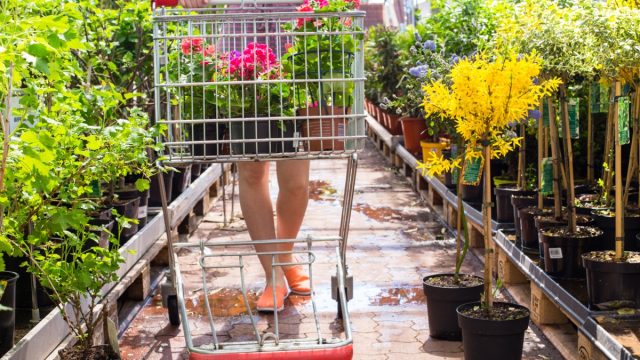
Picking plants and shrubs for your garden is exciting, especially if you enjoy spending time outside or have a green thumb. Even so, heading to the garden center or nursery can be overwhelming, with so many options to choose from, considering size, shape, color, and sunlight needs. But plant experts have a strategy that’ll help narrow down your search, as some plants for sale are actually dangerous invasive species.
According to the United States Department of Agriculture (USDA) Forest Service, invasive species are those that are non-native to a certain ecosystem and whose introduction “is likely to cause economic or environmental harm or harm to human health.” These plant varieties can pose a threat to surrounding wildlife, with some even disrupting the foundation of your home.
You might be asking yourself, “Why would garden centers sell these plants if they know that they can cause harm?” According to Charles van Rees, PhD, conservation scientist, naturalist, and founder of the Gulo in Nature blog, they don’t do it on purpose.
“The horticulture and gardening industries often sell invasive species accidentally,” van Rees tells Best Life. He adds that different factors affect this “invasive” designation—including how fast a plant reproduces, how it grows, and whether it will feed on or otherwise disrupt other plants.
Additionally, according to van Rees, if one of these plants is introduced to an environment that has a similar species, “it’s unlikely to cause a splash.” Issues arise when the native ecosystem has not “seen” this species before and lacks the defenses or “parts” to work alongside the new addition, he explains. “This can be really confusing for horticulturists and plant dealers, causing harm when they absolutely don’t mean to.”
Considering this information, the best way to keep your yard and the surrounding environment flourishing is to be aware of certain invasive species that are available for purchase. As an added bonus, with higher demand for native species, “we can take a major step toward a sustainable future,” van Rees says. Read on to find out which 7 plants you’ll want to avoid buying on your next trip to the garden center.
READ THIS NEXT: If You Have This Tree in Your Yard, Kill It and Cut It Down, Experts Warn.
1
Bamboo
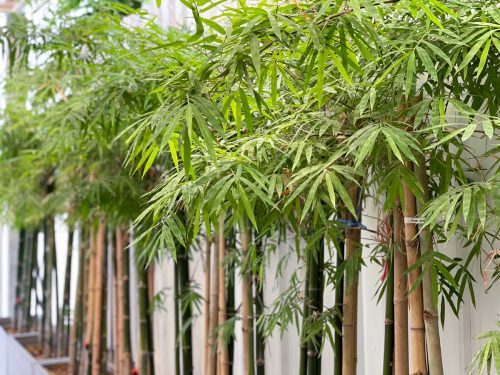
Bamboo was the most common response from experts when asked by Best Life about invasive species to avoid, and golden bamboo (Phyllostachys aurea) is actually classified as a terrestrial invasive by the USDA National Invasive Species Information Center. Commonly sold in garden centers, the real problem with bamboo is its knack for growing and spreading.
“Bamboo is a crowd favorite to use in design, but it is also considered to be one of the world’s most invasive plants,” Jason White, professional gardener and CEO of All About Gardening, explains. “It is undeniable that its slender form would make a beautiful screen, but that will turn into a garden disaster in no time because the plant has a very drastic growth spurt that makes it difficult to maintain.”
Bamboo sprouts can grow up to a foot in just one day, White says, and its roots present an additional problem, as they “can easily travel 20 feet deeper from the original clump.”
If you’re tempted to invest in some bamboo, you might want to think twice. “Avoid buying bamboo at all costs if you don’t want a maintenance nightmare in your suburban space,” White says.
2
Butterfly bush
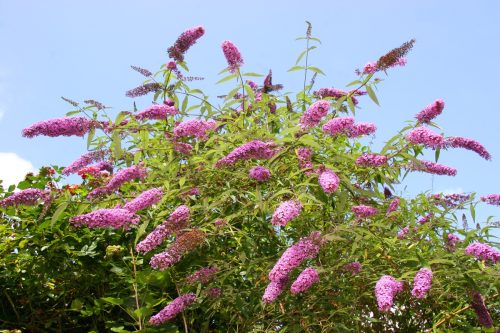
Butterfly bush is commonly sold in garden centers, but it is non-native to the U.S. and can replace native shrubs in surrounding areas, according to the Brandywine Conservancy. In addition, contrary to its name, the invasive butterfly bush (Buddleja davidii) is not going to do much to invite butterflies to your yard, van Rees says.
“Everyone buys it because it attracts butterflies, but not only does this plant disrupt native ecosystems when it spreads on its own, it’s really not that great for butterflies,” he explains. “My butterfly scientist colleagues consider it ‘junk food’ that gives butterflies a quick boost but no lasting nutrition.”
Butterflies can then choose to feed on the butterfly bush as opposed to other “healthier alternatives,” van Rees adds. He says planting a variety of wildflowers is a more effective strategy.
“An especially great place to start is with milkweeds, which support a huge variety of cool wildlife that won’t affect the rest of your garden, and support lots of butterflies, including monarchs,” van Rees tells Best Life.
For more gardening advice delivered straight to your inbox, sign up for our daily newsletter.
3
English ivy
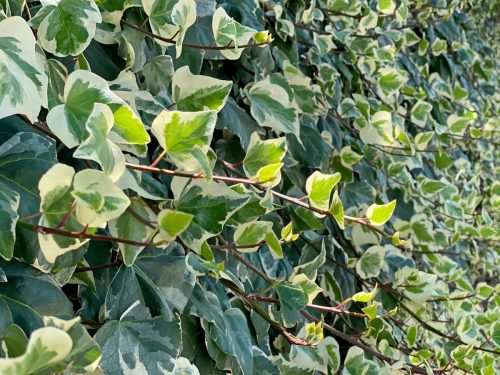
You’ve likely seen English ivy (Hedera helix) growing on homes, adding decoration to trellises. But plant experts say that you should be wary about purchasing this climbing beauty, as it can do more harm than good.
“It can strangle large trees and outcompete native vines that are super important for beautiful migratory birds, hummingbirds, butterflies, and many other important species,” van Rees says.
According to Brody Hall, certified horticulturist, certified conservationist and land manager, and co-founder at The Indoor Nursery, English ivy is invasive in Alabama, Arkansas, North Carolina, Virginia, and West Virginia.
In addition to choking out other plants, Hall says that it can cause skin irritation for humans. Jen Stark, master gardener and founder of Happy DIY Home, also states that this form of ivy “harbors many pests and diseases, which can then spread to the host plant.”
4
Japanese honeysuckle
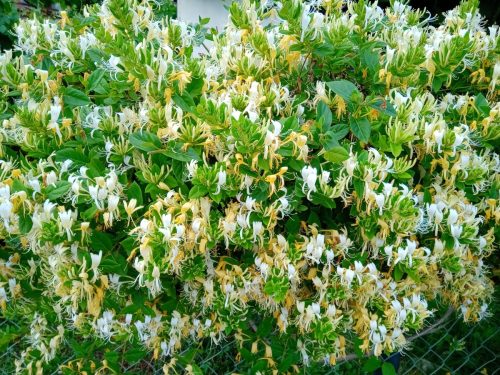
Particularly popular on the East Coast, another invasive plant you should skip at the garden center is Japanese honeysuckle (Lonicera japonica).
“This twining climber will choke everything in its path,” Vera Kutsenko, nature enthusiast and founder and CEO of the online home garden and lawn marketplace Neverland, explains. These plants grow quickly, reaching 15 to 30 feet in length, and their roots also spread at a rapid pace.
“This creates a hostile network of creeping roots that smother all foliage in its path, making it difficult to control,” Kutsenko says. “If you already have it in your yard or garden, you must constantly cut its growing roots and stem.”
READ THIS NEXT: If You See This Flower in Your Yard, Call Local Officials Immediately.
5
Purple loosestrife
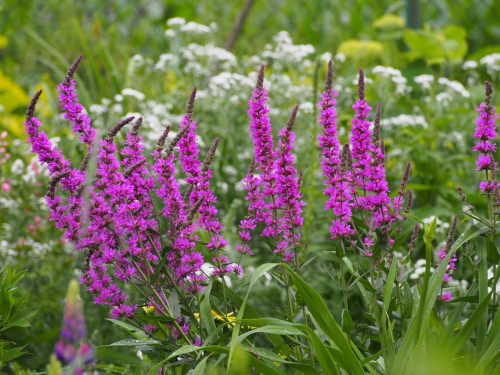
This flowering plant may look pretty, but it is invasive in every single U.S. state except for Florida, according to Hall. First introduced in the 1800s, purple loosestrife is native to Eurasia, according to the USDA.
The plant “outcompetes native plants that grow along the sides of shoreland areas,” he says, adding that if these plants are eaten, they can “cause diarrhea and menstrual issues.”
The purple loosestrife also impacts bird and butterfly populations and is “a very heavy feeder,” Charlotte Bailey, MSc, horticulturist of the specialist plant website Oh So Garden, tells Best Life. As a result, other species have fewer nutrients to feed on.
6
Chinese and Japanese privet
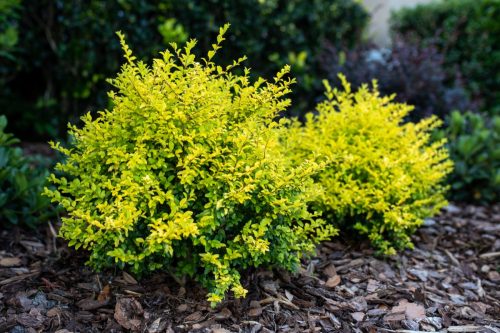
You might inadvertently purchase Chinese privet (Ligustrum sinense) or Japanese privet (Ligustrum japonicum) to line your yard, as it’s commonly for sale, but van Reese advises against it.
“This stuff is ruining riverside habitats all over the southeastern U.S.,” he says. “They are beautiful hedgerow plants requiring little maintenance and are widely sold, but they quickly take over and destroy lowland riparian forest because they have no natural predators here.”
According to the Clemson College of Agriculture, Forestry and Life Science, the Chinese privet, in particular, “is an aggressive and troublesome shrub,” producing thickets that effectively “choke out” surrounding native plants.
READ THIS NEXT: If You Have This Tree in Your Yard, Cut It Down Now, Officials Warn.
7
Periwinkle

Often sold as pretty ground cover, common periwinkle (Vinca minor) grows in “dense” mats, which allows it to effectively “displace woody and herbaceous species,” Bailey explains.
You might not realize that this pretty flower—famed for its color—could create an issue for your garden, but it’s invasive in most parts of the U.S., Hall tells Best Life.
It’s also toxic to some animals, he adds, and is dangerous to waterside (or riparian) areas, as it can overcome native plants and “alter the hydrological movement of waterways.”
According to Buffalo-Niagara Gardening, common periwinkle can easily spread outside of your garden, and experts recommend choosing a native groundcover instead.